Key Takeaways
- Discover the top 10 Customer Success Software in 2025 to boost retention, reduce churn, and enhance customer engagement.
- Compare features, integrations, and pricing to choose the best platform for your business needs.
- Leverage advanced tools and AI-driven insights to drive growth and strengthen long-term customer relationships.
In the rapidly evolving business landscape of 2025, organizations are increasingly recognizing that delivering exceptional products or services alone is no longer sufficient to ensure long-term growth and customer loyalty. The modern marketplace demands a proactive approach to customer engagement, one that not only addresses immediate needs but also anticipates future challenges and opportunities throughout the customer journey. This is where Customer Success Software has emerged as a critical strategic tool, enabling businesses to monitor, analyze, and optimize interactions with clients to maximize satisfaction, retention, and revenue.

Customer Success Software encompasses a comprehensive suite of digital tools designed to provide businesses with a unified view of their customers, track key performance metrics, predict churn risks, and facilitate proactive engagement strategies. These platforms allow organizations to move beyond traditional reactive customer service models, offering insights that empower teams to guide customers toward their desired outcomes. In 2025, the adoption of advanced technologies such as artificial intelligence (AI), machine learning (ML), and automation within Customer Success Software is transforming the way companies manage customer relationships. AI-powered predictive analytics identify at-risk accounts before they disengage, while automated workflows streamline routine processes, freeing customer success managers to focus on strategic initiatives and high-value interactions.
The selection of the right Customer Success Software can significantly impact business performance, particularly in industries that rely heavily on recurring revenue models such as SaaS, subscription services, and B2B solutions. These platforms not only help reduce customer churn but also facilitate upselling and cross-selling opportunities, ultimately contributing to increased customer lifetime value (CLV) and overall revenue growth. Furthermore, modern Customer Success Software supports multi-department collaboration, integrating seamlessly with CRM systems, marketing platforms, analytics tools, and support channels. This interconnected approach ensures a holistic understanding of the customer experience, allowing businesses to deliver personalized, data-driven engagement at scale.
In this competitive landscape, organizations have a growing need to identify the most effective and innovative Customer Success Software that aligns with their specific objectives, operational requirements, and growth strategies. The top platforms in 2025 distinguish themselves through their flexibility, scalability, and advanced features, such as customer health scoring, journey orchestration, automated workflows, real-time analytics, and AI-driven insights. Some tools are specifically optimized for enterprise-level deployments, providing robust reporting and integration capabilities, while others cater to startups and mid-sized businesses with simpler, user-friendly interfaces that accelerate onboarding and adoption.
This comprehensive guide examines the top 10 Customer Success Software solutions for 2025, offering an in-depth analysis of their key features, target markets, integration capabilities, and standout benefits. By exploring these platforms, businesses can make informed decisions, selecting software that not only meets current operational needs but also anticipates future demands in an increasingly digital and customer-centric marketplace. From enterprise-grade solutions designed to manage complex client portfolios to agile platforms optimized for SaaS companies and product-led teams, the 2025 Customer Success Software landscape provides a diverse array of tools engineered to empower businesses, strengthen customer relationships, and drive sustainable growth in the years ahead.
This blog aims to serve as a definitive resource for decision-makers, customer success managers, and business leaders seeking to leverage technology for maximizing customer retention, satisfaction, and revenue. Through detailed evaluations, comparisons, and insights, readers will gain a clear understanding of the strategic value offered by these platforms and how to implement them effectively to achieve measurable results. By the end of this guide, businesses will be well-equipped to navigate the dynamic Customer Success Software ecosystem of 2025, ensuring they select tools that foster long-term customer loyalty and competitive advantage.
Before we venture further into this article, we would like to share who we are and what we do.
About 9cv9
9cv9 is a business tech startup based in Singapore and Asia, with a strong presence all over the world.
With over nine years of startup and business experience, and being highly involved in connecting with thousands of companies and startups, the 9cv9 team has listed some important learning points in this overview of the Top 10 Best Customer Success Software To Use in 2025.
If your company needs recruitment and headhunting services to hire top-quality employees, you can use 9cv9 headhunting and recruitment services to hire top talents and candidates. Find out more here, or send over an email to [email protected].
Or just post 1 free job posting here at 9cv9 Hiring Portal in under 10 minutes.
Top 10 Best Customer Success Software To Use in 2025
- Gainsight
- ChurnZero
- ClientSuccess
- Totango
- Vitally
- Planhat
- Salesforce Service Cloud
- HubSpot Service Hub
- Zendesk
- Custify
1. Gainsight
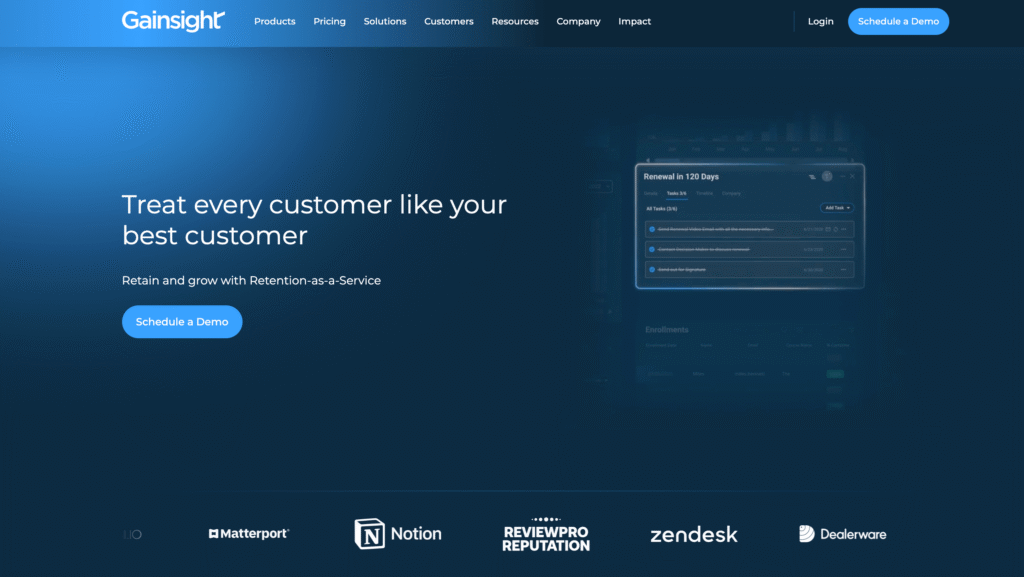
Gainsight emerges as one of the premier Customer Success software solutions in 2025, widely recognized for its robust capabilities tailored to enterprise-level organizations. It offers a comprehensive suite of tools that address virtually every aspect of customer success, positioning it as a go-to platform for companies seeking to enhance customer retention, optimize revenue, and strengthen long-term relationships.
Customer Intelligence and Analytics
Gainsight’s core strength lies in its ability to deliver a holistic understanding of each customer through its “Customer 360” framework. By aggregating data from multiple touchpoints, the platform allows organizations to track customer health, engagement, and lifecycle progress comprehensively. Key analytics include:
Customer Health Scoring
Journey Orchestration
Churn Prediction
Revenue Optimization
These features empower businesses to proactively manage accounts, anticipate challenges, and implement targeted strategies to maximize customer satisfaction and revenue growth.
Market Position and Industry Recognition
Gainsight has consistently been recognized as a leader in the Customer Success space. It holds a prominent position in the Gartner Magic Quadrant for Customer Success Management Platforms, reflecting its industry-wide acknowledgment for innovation, scalability, and strategic value. Market analyses indicate Gainsight commands a notable share of the enterprise customer success software market, with varying reports highlighting competitive influence ranging from 2% to 20%, demonstrating its widespread adoption among major organizations.
Customer Impact and Performance Metrics
Organizations leveraging Gainsight report impressive performance outcomes, with Net Revenue Retention often surpassing 100%. These results underscore the platform’s ability to drive measurable business impact. Customer reviews across technology assessment platforms frequently cite Gainsight’s depth of functionality, flexibility, and actionable insights, with an average satisfaction rating of 4.4 out of 5.
Integration and Platform Ecosystem
Gainsight’s integration capabilities further enhance its appeal, particularly for companies using Salesforce. Its native, bi-directional synchronization ensures seamless data flow, eliminating silos and enhancing operational efficiency. This integration allows teams to work within familiar CRM environments while leveraging Gainsight’s advanced customer success functionalities.
Enterprise Scalability and Deployment Considerations
While Gainsight delivers unmatched scalability for large and complex enterprises, it is also recognized for its sophisticated configuration requirements. Dedicated administrative resources are often necessary to maximize the platform’s potential. Pricing is typically customized to the organization’s scale and needs, reflecting a model designed for high-value enterprise clients.
Comparative Overview of Key Features
Feature | Description | Enterprise Value
Customer 360 View | Centralizes customer data across sources | Holistic customer insights
Health Scoring | Quantifies account risk and engagement | Proactive management of at-risk accounts
Journey Orchestration | Automates and personalizes customer interactions | Enhanced customer experience
Revenue Optimization | Identifies expansion opportunities | Drives measurable revenue growth
Salesforce Integration | Bi-directional CRM synchronization | Streamlined workflows and data consistency
Overall, Gainsight stands out as a leading Customer Success platform for enterprises in 2025. Its extensive feature set, proven market performance, and deep integration capabilities make it a strategic asset for organizations managing complex customer relationships, large datasets, and ambitious growth objectives. For companies aiming to excel in customer retention, account expansion, and predictive customer management, Gainsight remains a top-tier choice.
2. ChurnZero
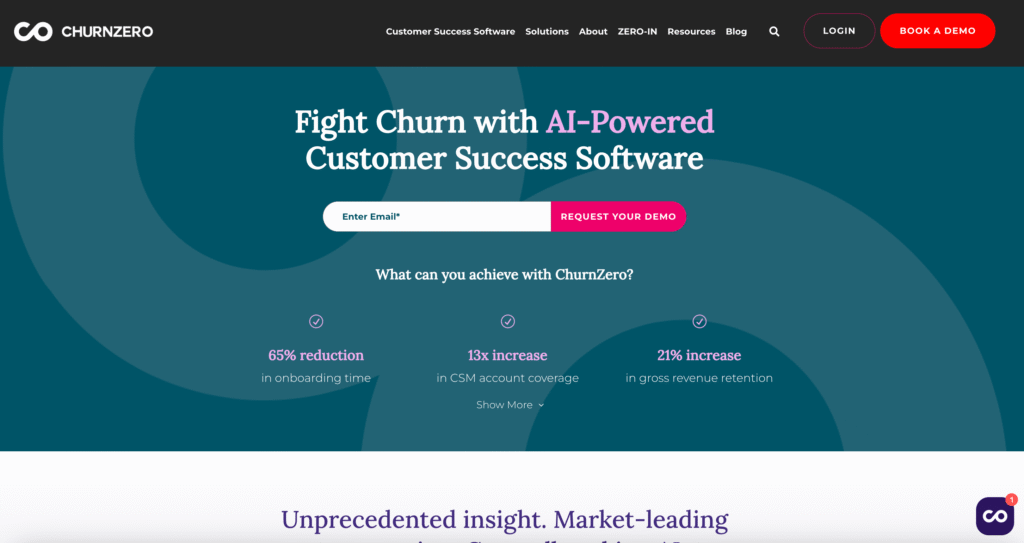
ChurnZero has emerged as a premier Customer Success software solution in 2025, recognized for its specialized capabilities that enable subscription-based and recurring-revenue businesses to scale effectively while minimizing customer attrition. Its strategic design and robust functionality make it particularly valuable for mid-market enterprises seeking to proactively manage churn and optimize customer retention.
Customer Engagement and Analytics
At the core of ChurnZero’s value proposition is its real-time customer usage analytics. The platform allows organizations to monitor engagement patterns, track behavioral signals, and identify potential churn risks before they escalate. Key analytical capabilities include:
Customer Usage Tracking
Churn Prediction and Risk Scoring
Renewal Forecasting
AI-Driven Recommendations for Customer Success Teams
These features provide actionable insights that empower businesses to implement proactive strategies, enhance customer satisfaction, and maximize long-term revenue potential.
Market Recognition and Industry Standing
ChurnZero has earned acclaim as a Leader in both the Gartner Magic Quadrant and the IDC MarketScape for Customer Success Applications, reflecting its consistent innovation and operational excellence. Market presence analyses indicate that ChurnZero commands a notable share of the customer success software ecosystem, with reported figures around 2.39%, demonstrating its growing adoption among mid-market enterprises globally.
Customer Outcomes and Performance Metrics
Organizations leveraging ChurnZero have achieved tangible results, including an average year-on-year churn reduction of approximately 20%. This underscores the platform’s effectiveness in driving measurable impact. User satisfaction ratings further reinforce its value, with G2 and Capterra scores consistently at 4.7 out of 5. Customers frequently highlight the platform’s intuitive interface, automated workflows, and actionable insights as key differentiators in enhancing customer success operations.
Integration and Ecosystem Connectivity
ChurnZero enhances operational efficiency through seamless integrations with major SaaS platforms such as Salesforce and HubSpot. These integrations allow for smooth data synchronization, unified workflows, and streamlined customer engagement processes. By embedding into existing technology stacks, ChurnZero enables organizations to leverage their data more effectively while maintaining consistency across multiple platforms.
Scalability and Deployment Considerations
While designed with mid-market enterprises in mind, ChurnZero scales effectively to accommodate growing businesses. Pricing structures are generally tailored to organizational needs, with baseline packages reportedly starting at $12,000 annually. The platform’s ease of use, coupled with its automation capabilities, reduces the administrative burden on customer success teams, allowing them to focus on strategic initiatives rather than manual processes.
Comparative Overview of Key Features
Feature | Description | Enterprise Value
Real-Time Usage Analytics | Monitors customer engagement patterns | Early detection of churn risks
Churn Prediction | Calculates likelihood of account attrition | Enables proactive retention strategies
Renewal Forecasting | Tracks and predicts subscription renewals | Supports revenue continuity
AI-Powered Recommendations | Suggests targeted interventions | Enhances decision-making for CS teams
SaaS Integrations | Connects with platforms like Salesforce and HubSpot | Streamlined workflow and unified data
Overall, ChurnZero’s targeted approach to minimizing customer churn, combined with its powerful analytics, AI-driven recommendations, and seamless integrations, positions it as one of the top Customer Success software solutions for 2025. Its focus on proactive retention, user-friendliness, and measurable business outcomes makes it an ideal choice for mid-market companies committed to scaling their customer success operations effectively.
3. ClientSuccess
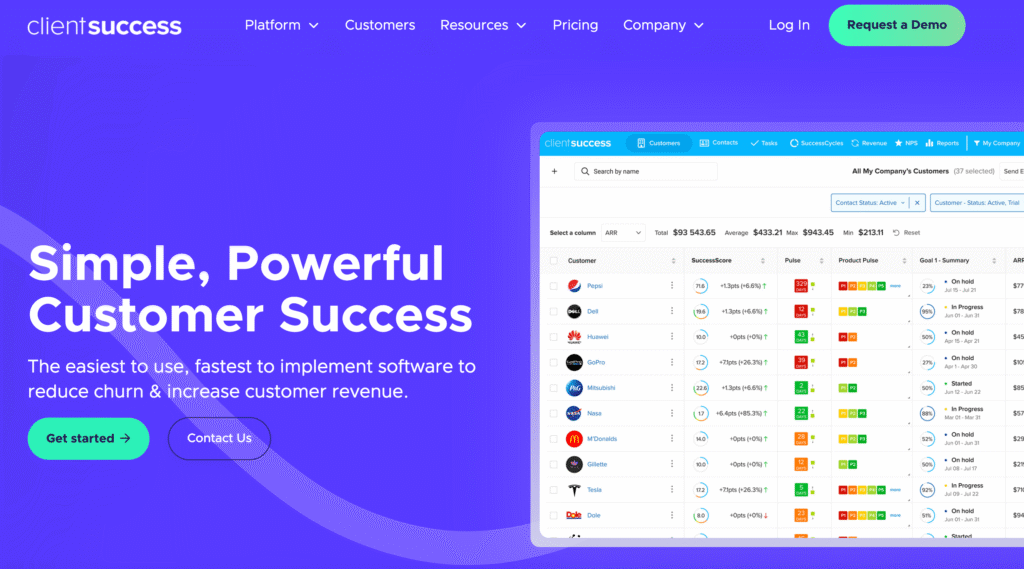
ClientSuccess has positioned itself as one of the top Customer Success software solutions for 2025, recognized for its tailored approach to managing client relationships across the entire customer lifecycle. Its design emphasizes simplicity without compromising functionality, making it particularly appealing to startups and growing businesses seeking actionable insights and streamlined processes.
Customer Lifecycle Management
ClientSuccess provides a comprehensive view of the customer journey, enabling organizations to monitor every stage from onboarding through renewals and potential churn. Core capabilities include:
Customer Journey Tracking
Goal Tracking and Performance Metrics
Lifecycle Automation for Triggered Actions
These functionalities ensure that businesses can proactively manage customer success, identify at-risk accounts, and implement strategies that optimize retention and growth.
Ease of Use and Operational Efficiency
A defining characteristic of ClientSuccess is its intuitive interface, which allows teams to leverage its features without requiring a dedicated administrator. Users frequently cite its straightforward setup, minimal learning curve, and ease of ongoing maintenance as significant advantages. By simplifying complex processes, the platform empowers customer success teams to focus on strategic initiatives rather than routine administrative tasks.
Market Presence and Recognition
ClientSuccess has garnered positive industry feedback, achieving a G2 rating of 4.4 out of 5 and a Capterra rating of 4.2 out of 5. Its annual revenue is estimated at approximately $3.6 million, reflecting steady adoption among small to mid-sized businesses. These metrics highlight the platform’s credibility and growing relevance in the competitive customer success software landscape.
Integration Capabilities and Ecosystem Connectivity
The platform supports seamless integration with leading CRM, support, and communication systems, including Salesforce, HubSpot, and Zendesk. This connectivity allows businesses to consolidate data from multiple touchpoints, enabling a unified approach to customer relationship management. By leveraging these integrations, ClientSuccess ensures that customer insights are accurate, actionable, and accessible across teams.
Comparative Overview of Key Features
Feature | Description | Business Value
Customer Journey Tracking | Monitors engagement and progression across the lifecycle | Provides holistic customer insights
Goal Tracking | Measures success against defined objectives | Enables data-driven decision-making
Lifecycle Automation | Automates actions at key customer milestones | Reduces manual workload and enhances efficiency
CRM Integrations | Connects with Salesforce, HubSpot, Zendesk | Centralized customer data for better insights
User-Friendly Interface | Intuitive setup and navigation | Quick adoption and minimal administrative effort
Strategic Advantages
ClientSuccess combines simplicity with robust functionality, offering a balance that is particularly advantageous for startups and mid-sized businesses. Its focus on actionable insights, automation, and holistic lifecycle management makes it a practical yet powerful solution for companies aiming to optimize customer retention, improve engagement, and drive measurable business outcomes.
Overall, ClientSuccess stands out in 2025 as a top-tier Customer Success software, delivering a thoughtful blend of usability, comprehensive features, and integration capabilities that empower organizations to manage their customer relationships efficiently and effectively.
4. Totango
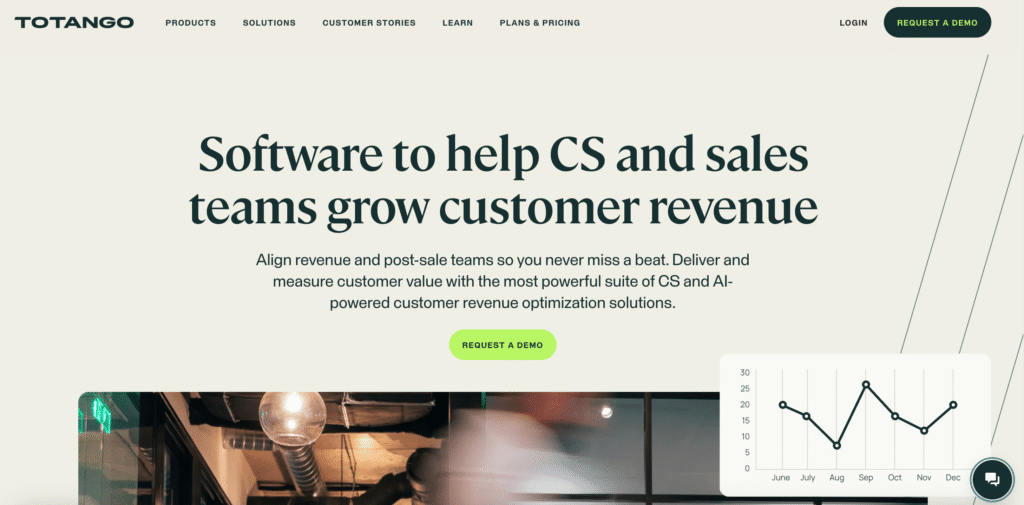
Totango has established itself as a leading Customer Success software solution in 2025, recognized for its comprehensive approach to improving customer engagement, retention, and revenue growth. Its advanced features and scalable architecture make it an essential tool for businesses aiming to optimize customer success operations while delivering measurable value across the entire customer lifecycle.
Customer Engagement and Retention
At the heart of Totango’s capabilities is its ability to drive meaningful engagement and reduce churn. The platform provides a full suite of tools designed to guide customer success teams through every phase of the user journey. Core functionalities include:
Customizable Workflows with Plug-and-Play Templates
Task Management and Team Collaboration Tools
Advanced Segmentation Engine for Targeted Interventions
By leveraging these features, organizations can implement proactive strategies that prevent churn, enhance adoption, and increase lifetime customer value.
Market Presence and Industry Impact
Totango has earned recognition as a major competitor in the Customer Success software landscape, commanding an estimated market share of 15%. The platform has received positive reviews across multiple evaluation platforms, including a G2 rating of 4.4 out of 5 and a Capterra rating of 4.0 out of 5. Customers have reported measurable outcomes, such as significant productivity improvements and an average churn reduction of 20%, underscoring the platform’s effectiveness in driving tangible business results.
Integration and Ecosystem Connectivity
Totango offers robust integration capabilities through its built-in data hub, which facilitates connections to popular SaaS tools including Salesforce, HubSpot, and Zendesk. The platform’s library of JavaScript code snippets allows seamless integration with existing workflows, ensuring that customer data from multiple sources is consolidated into a unified view. This capability enables teams to make informed, data-driven decisions while minimizing the friction associated with disparate systems.
Enterprise Scalability and Deployment
A standout feature of Totango is its ability to provide rapid deployment through pre-built frameworks embedded with workflows and content. This approach reduces implementation time, allowing teams to quickly operationalize best practices for customer success. The recent acquisition of Catalyst further strengthens Totango’s platform, expanding its capabilities in customer growth and analytics while reinforcing its position as a top-tier solution for enterprises aiming to scale their customer success efforts efficiently.
Comparative Overview of Key Features
Feature | Description | Enterprise Value
Customizable Workflows | Pre-built and editable templates for all journey stages | Streamlines operations and accelerates success initiatives
Segmentation Engine | Advanced segmentation of customers based on behavior and usage | Enables targeted interventions for churn reduction and growth
Task and Team Management | Assign, track, and collaborate on tasks | Enhances team efficiency and accountability
Data Hub Integrations | Connects with Salesforce, HubSpot, Zendesk, and other tools | Consolidates customer insights for informed decision-making
Pre-Built Frameworks | Embedded best practices for rapid deployment | Reduces time-to-value and operational complexity
Strategic Advantages
Totango’s combination of user-friendliness, powerful analytics, and scalable architecture positions it as a trusted platform for driving customer success initiatives. Its focus on workflow automation, centralized data access, and actionable insights makes it particularly effective for enterprises seeking to increase adoption, reduce churn, and enhance overall customer value.
Overall, Totango stands out in 2025 as one of the top Customer Success software solutions, delivering a robust, flexible, and integrated platform that empowers organizations to achieve measurable outcomes while scaling their customer success operations with efficiency and precision.
5. Vitally
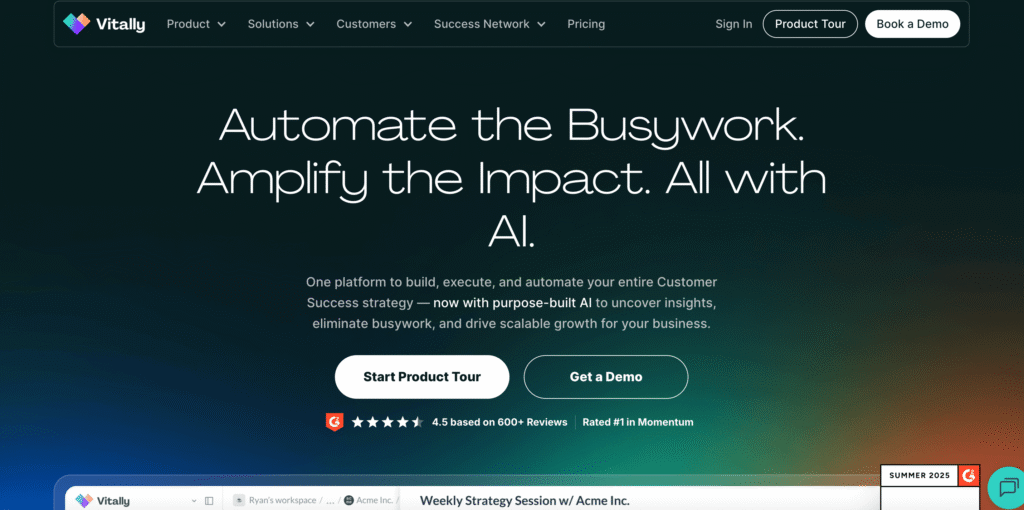
Vitally has distinguished itself as a premier Customer Success software solution in 2025, recognized for its unique focus on productivity, collaboration, and streamlined workflow management. Its innovative design enables organizations to drive product adoption, strengthen customer relationships, and improve operational efficiency, making it a top choice for businesses of varying sizes seeking to optimize customer success outcomes.
Enhanced Collaboration and Productivity
Vitally emphasizes team collaboration and visibility as central pillars of its platform. By integrating project management tools directly into the customer success environment, it allows teams to coordinate seamlessly. Core functionalities include:
Kanban Boards and Table Views for Task and Account Management
Assignment of Tasks to Team Members or Customer Success Managers
Vitally Docs for Real-Time Collaboration with Coworkers and Customers
Visual Workflow Builder for Automating Processes Based on Custom Conditions
These features empower teams to manage customer interactions efficiently, ensure accountability, and maintain clear oversight of ongoing initiatives, thereby driving higher engagement and adoption rates.
Customer Analytics and Insights
Vitally provides robust customer health scoring to evaluate engagement and risk levels. While its native analytics may not be as extensive as some larger competitors, the platform’s drag-and-drop custom dashboards allow teams to visualize key metrics, build actionable insights, and monitor performance trends in real time. This flexibility ensures that decision-makers have the necessary intelligence to proactively manage accounts and identify growth opportunities.
Market Recognition and User Satisfaction
Vitally has earned significant acclaim in the Customer Success software landscape. The platform holds a G2 rating of 4.6 out of 5 and has been recognized as the #1 Momentum Leader in the Customer Success category on G2, reflecting its rapid adoption, market growth, and increasing preference among organizations seeking modern, collaborative tools. Users consistently highlight its intuitive interface, configurability, and responsive customer support as major advantages.
Integration Ecosystem and Connectivity
Vitally supports integrations with 28 leading tools, including Amplitude, Mixpanel, Segment, Salesforce, and HubSpot. This connectivity enables seamless synchronization of customer data across multiple platforms, ensuring a centralized view of all relevant information. These integrations enhance productivity and allow teams to operate without disruption, consolidating insights from analytics, CRM, and product usage data.
Deployment Flexibility and Pricing
Vitally accommodates diverse customer success models, including tech-touch, high-touch, and hybrid-touch approaches. Pricing follows a quote-based structure tailored to the organization’s size, engagement model, and specific needs. This flexibility allows businesses to scale their customer success operations efficiently while maintaining cost-effectiveness.
Comparative Overview of Key Features
Feature | Description | Business Value
Kanban & Table Views | Visual task and account management tools | Enhances team collaboration and accountability
Vitally Docs | Real-time document collaboration | Streamlines communication with teams and customers
Visual Workflow Builder | Automates processes based on conditions | Reduces manual intervention and ensures consistent actions
Custom Dashboards | Drag-and-drop widgets for analytics | Provides actionable insights and monitors performance trends
Integrations | Connects with 28 SaaS tools including Salesforce and HubSpot | Consolidates data for informed decision-making
Strategic Advantages
Vitally’s combination of collaborative features, visual workflow automation, and customizable dashboards positions it as a forward-thinking solution for customer success teams. Its focus on productivity, visibility, and cross-functional collaboration enables businesses to track customer progress efficiently, align team efforts, and accelerate product adoption.
Overall, Vitally stands out in 2025 as one of the top Customer Success software platforms, offering a modern, collaborative, and highly configurable environment that empowers organizations to enhance customer engagement, improve retention, and drive measurable business outcomes.
6. Planhat
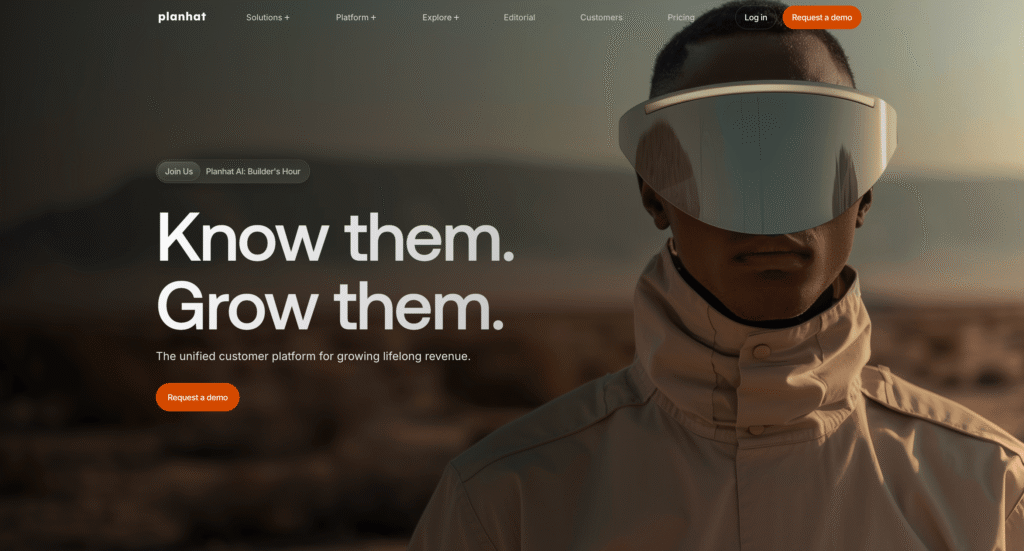
Planhat has established itself as one of the top Customer Success software solutions in 2025, distinguished by its robust data architecture, high customizability, and user-centric design. The platform is engineered to help organizations optimize customer relationships, improve engagement, and drive measurable business outcomes, making it a preferred choice for companies seeking both power and flexibility in customer success management.
Comprehensive Data Management and Analytics
Planhat excels in aggregating and analyzing customer data through a highly extensible data foundation. Its sophisticated analytics capabilities allow organizations to capture, visualize, and interpret trends across the customer lifecycle. Key features include:
Customizable Data Models to tailor insights to unique business needs
Health Scores for assessing customer engagement and risk levels
Dashboards and Reporting Tools for actionable visual analytics
These capabilities enable businesses to gain a holistic view of customer behavior, anticipate potential churn, and make informed decisions that maximize customer lifetime value.
Market Recognition and Industry Leadership
Planhat has garnered significant industry recognition, receiving a 4.7 out of 5 rating on both Appvizer and Capterra. In 2024, it was named a Customer Success Leader by IDC, highlighting its innovative product design, flexibility, and ability to provide actionable insights from complex customer data. Users frequently cite the platform’s intuitive interface and responsive customer support as key differentiators that enhance usability and adoption.
Customer Relationship Management and Workflow Automation
Designed for versatility, Planhat allows organizations to manage customer relationships seamlessly while automating repetitive tasks. Core functionalities include:
Creation of Customized Customer Success Plans for targeted engagement
Automated Customer Communications to maintain consistent interaction
Monitoring of Customer Health Scores to identify at-risk accounts
These features ensure that teams can proactively engage customers, streamline workflows, and optimize the customer journey for maximum retention and satisfaction.
Integration and Extensibility
Planhat provides extensive integration capabilities through native connections and a flexible API, enabling organizations to consolidate data from multiple platforms efficiently. This connectivity allows for a unified view of customer information, improving operational efficiency and supporting data-driven decision-making.
Comparative Overview of Key Features
Feature | Description | Business Value
Customizable Data Models | Tailor analytics to specific business needs | Enables precise, actionable insights
Health Scores | Evaluate engagement and churn risk | Supports proactive customer retention strategies
Dashboards & Reporting | Visualize trends and performance metrics | Facilitates informed decision-making and strategy adjustments
Workflow Automation | Automates customer communications and tasks | Reduces manual effort and ensures consistency
Integrations & Flexible API | Connects with multiple SaaS platforms | Consolidates customer data for unified analytics
Strategic Advantages
Planhat’s combination of a powerful data foundation, intuitive interface, and flexible workflow automation positions it as a top-tier solution for organizations seeking a high-performance customer success platform. Its ability to scale with business needs, while providing actionable insights and customizable tools, ensures that companies of all sizes can optimize engagement, improve retention, and achieve measurable growth.
Overall, Planhat’s innovative approach to customer success, coupled with its flexibility, analytics capabilities, and integration options, makes it a leading choice in 2025 for organizations committed to delivering exceptional customer experiences and driving sustained business success.
7. Salesforce Service Cloud

Salesforce Service Cloud has established itself as one of the premier Customer Success software solutions in 2025, leveraging the robust capabilities of the Salesforce CRM platform to deliver a unified, AI-driven environment for managing customer interactions. Its extensive functionality, integration potential, and scalability make it a top choice for enterprises seeking a holistic approach to customer success, service, and engagement.
Unified Customer Engagement
Service Cloud centralizes all customer interactions into a single AI-powered workspace, providing teams with the tools to manage and optimize the customer lifecycle effectively. Key features include:
Case Management for tracking and resolving customer issues efficiently
Knowledge Management to provide teams with instant access to relevant resources
Intelligent Service Operations powered by AI for predictive insights and automation
Omnichannel Support to handle customer inquiries across email, chat, phone, and social media
These capabilities allow organizations to enhance response times, deliver consistent experiences, and proactively address customer needs, which ultimately drives satisfaction and loyalty.
Market Leadership and Recognition
Salesforce consistently maintains its position as a leader in the CRM space, holding a significant market share. While Salesforce Service Cloud does not always feature separate ratings for customer success, the platform as a whole is recognized as a Leader in the G2 Grid for Customer Success. Capterra ratings for Service Cloud as a help desk software are approximately 4.4 out of 5, reflecting widespread user satisfaction. Its reputation is further strengthened by the extensive ecosystem of Salesforce integrations and its ability to adapt to enterprise-level requirements.
Integration Capabilities and Ecosystem Connectivity
A major advantage of Service Cloud lies in its seamless integration with the broader Salesforce ecosystem, connecting sales, service, marketing, and commerce data. This unified approach provides teams with a 360-degree view of the customer, allowing for more strategic decision-making and better-aligned operations. Native integrations and API support ensure that organizations can incorporate additional tools and data sources without disrupting workflows.
Scalability and Deployment Considerations
Salesforce Service Cloud is designed for enterprise-level deployment, offering extensive customization options to meet complex business requirements. However, the breadth of features can be overwhelming for new users, often necessitating dedicated training, onboarding programs, and internal administrative resources. Pricing varies according to edition, feature selection, and organizational scale, reflecting a tailored approach suited for larger businesses seeking comprehensive customer success and service solutions.
Comparative Overview of Key Features
Feature | Description | Enterprise Value
AI-Powered Workspace | Centralized platform for all customer interactions | Enhances efficiency and consistency across teams
Case Management | Tracks and resolves customer issues | Improves response time and customer satisfaction
Knowledge Management | Provides instant access to relevant resources | Reduces resolution times and empowers teams
Omnichannel Support | Manages inquiries across multiple channels | Delivers consistent, seamless customer experiences
Salesforce Integration | Unified view across CRM, marketing, sales, and commerce | Supports strategic decision-making and operational alignment
Strategic Advantages
Salesforce Service Cloud’s combination of AI-driven workflows, omnichannel support, and deep integration within the Salesforce ecosystem positions it as an ideal platform for enterprise teams. Its ability to centralize customer interactions, deliver actionable insights, and provide extensive customization options ensures that organizations can scale their customer success efforts efficiently and effectively.
Overall, Salesforce Service Cloud stands out in 2025 as a top-tier Customer Success software, particularly for businesses already embedded in the Salesforce ecosystem. Its comprehensive suite of features, strong market presence, and capacity for enterprise-level customization make it a leading solution for organizations seeking to optimize customer engagement, retention, and satisfaction across complex operational environments.
8. HubSpot Service Hub
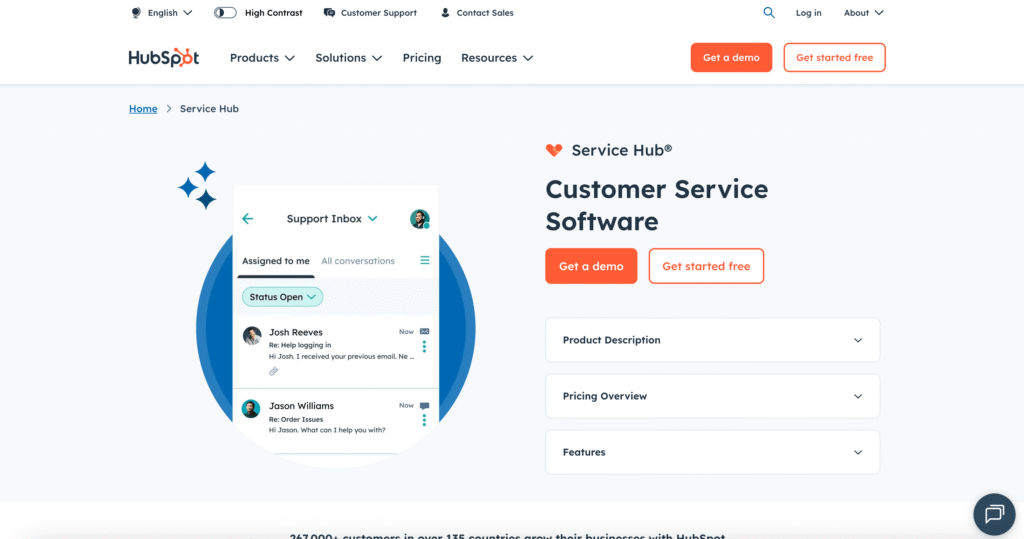
HubSpot Service Hub has emerged as one of the leading Customer Success software solutions in 2025, offering a unified platform that combines customer support, success management, and omnichannel engagement. Its integration with the broader HubSpot ecosystem and user-centric design make it particularly suitable for small to medium-sized businesses seeking an accessible yet powerful solution for managing the entire customer lifecycle.
Unified Customer Support and Success
HubSpot Service Hub centralizes customer interactions within a single, AI-powered help desk, enabling teams to manage inquiries efficiently while improving retention and satisfaction. Key functionalities include:
Customer Health Scoring to monitor engagement and predict churn
Churn Reduction Tools that provide actionable insights for retention strategies
Omnichannel Support across email, chat, phone, and social media platforms
Ticket Management and Automation for streamlined service workflows
These features allow organizations to deliver consistent, personalized experiences while proactively addressing potential challenges in the customer journey.
Market Presence and Industry Recognition
HubSpot holds a dominant position in the marketing automation and CRM space, maintaining the largest global market share. While Service Hub’s G2 ratings for customer success vary, HubSpot as a company consistently receives high praise for innovation and usability. In 2023, the company achieved $2.17 billion in revenue, reflecting strong adoption and an expanding customer base. Users frequently highlight the platform’s intuitive interface and the seamless integration with HubSpot’s Marketing and Sales Hubs as key advantages that facilitate a centralized approach to managing customer relationships.
Integration Ecosystem and Flexibility
A major strength of Service Hub is its native integration with the full HubSpot ecosystem, which allows marketing, sales, and service teams to operate cohesively. Additionally, a robust app marketplace provides access to numerous third-party integrations, extending functionality and ensuring that organizations can consolidate customer data from multiple sources. This connectivity enhances operational efficiency and supports informed decision-making.
Accessibility and Scalability
HubSpot Service Hub offers a tiered pricing structure, beginning with a free plan that provides essential customer support functionalities, making it ideal for startups and small businesses. Advanced plans unlock more sophisticated features, such as automation, advanced reporting, and predictive analytics, allowing organizations to scale their customer success operations in line with growth. The platform’s accessibility and scalability ensure that businesses of all sizes can adopt best-in-class customer success practices without significant upfront investment.
Comparative Overview of Key Features
Feature | Description | Business Value
AI-Powered Help Desk | Centralized platform for managing customer inquiries | Streamlines operations and improves response times
Customer Health Scoring | Monitors engagement and predicts churn risk | Enables proactive retention strategies
Omnichannel Support | Handles communication across multiple channels | Provides consistent, personalized customer experiences
Integration with HubSpot Hubs | Connects Marketing, Sales, and Service Hubs | Facilitates unified operations and data visibility
Tiered Pricing & Accessibility | Free and advanced plans for various business sizes | Supports adoption across startups, SMBs, and growing enterprises
Strategic Advantages
HubSpot Service Hub’s combination of user-friendliness, seamless integration, and AI-powered features positions it as a strategic tool for businesses seeking to unify their customer engagement, retention, and service initiatives. Its ability to consolidate marketing, sales, and support workflows ensures that teams can collaborate effectively, delivering measurable business outcomes and enhanced customer satisfaction.
Overall, HubSpot Service Hub stands out in 2025 as a top-tier Customer Success software, particularly for small to medium-sized businesses and existing HubSpot users. Its comprehensive feature set, scalability, and integration capabilities make it a trusted platform for managing the customer journey, improving retention, and driving long-term growth.
9. Zendesk

Zendesk has solidified its position as one of the leading Customer Success software solutions in 2025, offering a comprehensive suite of tools that combine advanced customer support functionalities with intelligent customer experience management. Its integration of AI-powered capabilities, scalable architecture, and extensive ecosystem connectivity make it a preferred choice for businesses aiming to enhance customer engagement, streamline support operations, and drive measurable success outcomes.
Comprehensive Customer Support and Success
Zendesk provides an all-in-one platform for managing customer interactions across multiple channels. Its capabilities extend beyond traditional support, offering features designed to improve retention and customer satisfaction. Core functionalities include:
Live Chat and Ticketing Systems for immediate and organized issue resolution
Phone Support and Self-Service Portals for flexible, 24/7 customer assistance
AI-Powered Agents capable of handling multi-turn conversations and providing proactive support
Knowledge Base Management for centralized access to information and best practices
By offering these features, Zendesk empowers teams to resolve inquiries efficiently, predict potential issues, and maintain consistent, high-quality customer experiences.
Market Presence and Industry Recognition
Zendesk maintains a significant share of the customer support software market, reflecting its widespread adoption and strong reputation. The platform has received a G2 rating of 4.3 out of 5 and a Capterra rating of 4.4 out of 5, highlighting user satisfaction across ease of use, scalability, and comprehensive support channels. Its revenue reached $1.93 billion in 2024, demonstrating its solid market presence and the value organizations place on its customer experience capabilities.
Integration and Ecosystem Connectivity
One of Zendesk’s strongest advantages is its extensive integration ecosystem, supporting over 1,000 third-party applications, including major platforms like Salesforce and Slack. These integrations enable seamless data consolidation, enhance workflow efficiency, and facilitate cross-functional collaboration. The platform’s adaptability ensures that businesses of varying sizes and industries can tailor Zendesk to their specific customer success needs, even when complex customization is required.
AI Capabilities and Intelligent Customer Experience
Zendesk leverages artificial intelligence to enhance operational efficiency and customer satisfaction. Its AI agents can conduct multi-turn conversations, resolve repetitive queries autonomously, and provide predictive insights to help teams act proactively. This approach ensures that businesses can deliver a modern, intelligent, and responsive customer experience while reducing the burden on human agents.
Comparative Overview of Key Features
Feature | Description | Business Value
Live Chat & Ticketing | Real-time communication and organized issue tracking | Increases efficiency and reduces response times
Phone Support & Self-Service | Multiple channels for customer engagement | Ensures 24/7 accessibility and convenience
AI-Powered Agents | Handles multi-turn conversations and predictive support | Enhances CX and reduces agent workload
Knowledge Base Management | Centralized repository for customer resources | Improves resolution speed and customer satisfaction
Integration Ecosystem | Supports 1000+ apps including Salesforce and Slack | Consolidates data and enables seamless workflow automation
Scalability and Deployment
Zendesk’s flexible architecture allows it to scale across small businesses, mid-sized companies, and large enterprises. While customization may be necessary to align with specific business processes, its intuitive interface, robust integrations, and AI-driven capabilities ensure teams can efficiently implement and maintain the platform. Pricing varies per agent per month, offering scalable options suitable for diverse business sizes and requirements.
Strategic Advantages
Zendesk’s combination of AI-driven customer support, multichannel capabilities, and extensive integrations positions it as a top-tier solution for organizations focused on both customer service and customer success. Its ability to unify interactions, automate workflows, and provide actionable insights ensures that businesses can proactively manage customer relationships while optimizing operational efficiency.
Overall, Zendesk stands out in 2025 as one of the best Customer Success software solutions, offering a scalable, AI-enhanced, and highly integrative platform that empowers organizations to improve customer satisfaction, reduce churn, and drive long-term engagement across a wide range of industries.
10. Custify
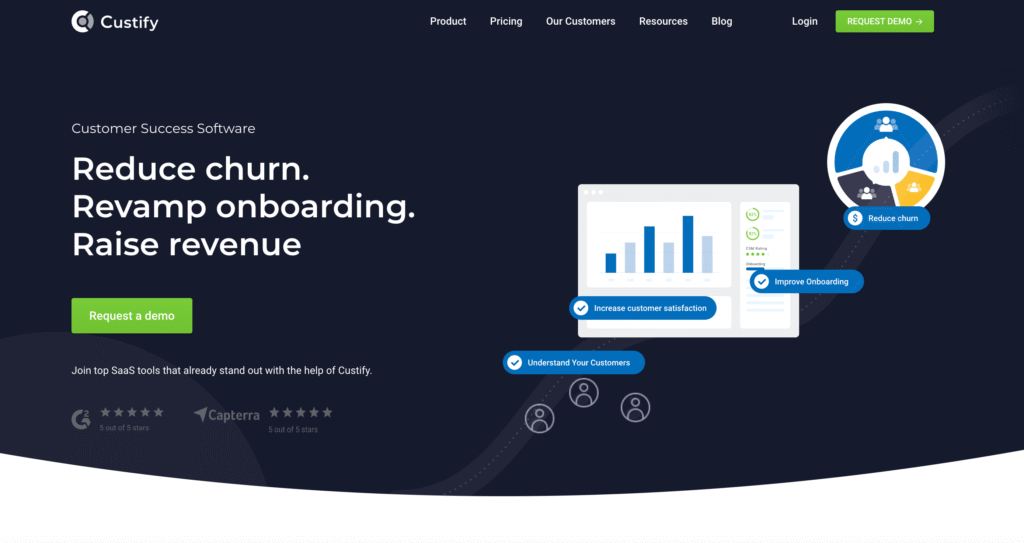
Custify has positioned itself as one of the leading Customer Success software solutions in 2025, offering a specialized platform tailored for B2B SaaS businesses. By combining real-time analytics, proactive engagement tools, and seamless integrations, Custify empowers organizations to monitor customer health, reduce churn, and drive sustainable growth, making it a strong contender among the top Customer Success platforms.
Comprehensive Customer Health Monitoring
Custify provides a 360-degree view of each customer, allowing teams to gain complete visibility into engagement, satisfaction, and potential risks. Core functionalities include:
Customizable Customer Health Scores to evaluate account performance and predict churn
Real-Time Engagement Tracking to monitor usage patterns and identify at-risk accounts
Proactive Alerts and Automated Workflows to trigger timely interventions
Customer Segmentation for tailored outreach and personalized engagement strategies
These features enable businesses to act swiftly on insights, maintain high retention rates, and foster stronger customer relationships.
Market Recognition and User Satisfaction
Although Custify’s market share is smaller compared to larger enterprise solutions, it has earned strong recognition in the customer success space. The platform boasts a G2 rating of 4.7 out of 5 and a Capterra rating of 4.9 out of 5, reflecting high user satisfaction. Reviewers frequently highlight Custify’s intuitive interface, ease of use, and responsive customer support as key advantages that reduce onboarding time and facilitate adoption across teams.
Integration Capabilities and Ecosystem Connectivity
Custify offers seamless integrations with leading CRM systems, support platforms, and communication tools, allowing for a unified view of customer data. These integrations help teams consolidate information, automate workflows, and streamline collaboration between departments, ensuring that every interaction is informed and consistent.
Analytics and Workflow Automation
A distinguishing feature of Custify lies in its powerful analytics and automation capabilities. Teams can leverage detailed reporting to identify trends, monitor performance metrics, and forecast churn risk. Automated workflows ensure that routine tasks—such as follow-up emails, account check-ins, or alerts for declining engagement—are handled efficiently, allowing customer success teams to focus on strategic initiatives.
Comparative Overview of Key Features
Feature | Description | Business Value
Customer Health Scores | Customizable metrics to assess account health | Enables proactive retention strategies and risk mitigation
Real-Time Engagement Tracking | Monitors usage and behavior patterns | Identifies at-risk accounts early and supports timely interventions
Automated Workflows | Automates follow-ups and engagement tasks | Enhances operational efficiency and consistency in customer communications
Customer Segmentation | Groups accounts based on behavior and risk | Allows for personalized outreach and improved engagement
CRM and Tool Integrations | Connects with leading CRMs and support platforms | Consolidates data for a unified customer view and streamlined workflows
Strategic Advantages
Custify’s emphasis on proactive engagement, real-time insights, and automation positions it as a highly effective tool for B2B SaaS businesses. By enabling teams to anticipate customer needs, segment accounts intelligently, and execute tailored communication strategies, Custify helps organizations increase retention, reduce churn, and cultivate long-term loyalty.
Overall, Custify stands out in 2025 as a top Customer Success software solution, particularly for B2B SaaS companies seeking a highly intuitive, proactive, and analytics-driven platform. Its combination of real-time monitoring, automation, and seamless integrations makes it a trusted choice for businesses committed to optimizing customer success and maximizing lifetime value.
Defining Customer Success Software
Customer Success Software represents a sophisticated suite of tools and platforms specifically engineered to enable businesses to proactively manage the entire customer lifecycle. Its primary objective is to ensure clients derive maximum value from a company’s products or services, transforming the relationship from transactional interactions to strategic engagement. Key functionalities commonly include:
Account Health Tracking – Monitors key performance indicators to gauge customer satisfaction, identify at-risk accounts, and prioritize engagement strategies.
Churn Prediction – Employs historical data, behavioral analytics, and machine learning algorithms to forecast customers likely to discontinue usage, allowing timely interventions.
Onboarding Workflow Management – Streamlines the initial adoption process, ensuring customers quickly achieve value while minimizing friction and potential frustration.
Customer Journey Mapping – Provides a visual overview of touchpoints across the customer lifecycle, facilitating optimization of interactions and enhanced experience delivery.
By integrating these capabilities, Customer Success Software empowers organizations to shift from a reactive problem-solving approach to a proactive strategy that actively guides customers toward desired outcomes. This approach strengthens relationships, fosters loyalty, and increases long-term retention.
The Critical Role of Customer Success in Modern Business
The evolution of customer engagement has shifted from traditional reactive service models—focused primarily on resolving problems as they arise—to a forward-looking, proactive approach centered on ensuring customer success. In the contemporary business environment, merely addressing complaints is insufficient; organizations must help customers maximize value from products and services.
Proactive Customer Engagement Directly Impacts Key Metrics
Customer retention improves markedly when businesses prioritize customer success, as satisfied clients are more likely to remain loyal. Higher retention drives increased Customer Lifetime Value (CLV), representing total revenue potential over the course of the customer relationship. Effective customer success strategies also unlock upsell and cross-sell opportunities and convert satisfied clients into brand advocates. Research indicates that organizations with high retention rates can achieve up to 25% more revenue compared to peers with lower retention. Additionally, investments in dedicated customer success teams and supporting technology can deliver impressive returns, with risk-adjusted ROI estimates reaching 107% over three years.
Key Market Drivers and Emerging Trends for 2025
The Customer Success Software landscape in 2025 is influenced by several market drivers and technological trends:
Subscription Economy Expansion – The widespread adoption of subscription-based business models has increased the strategic importance of customer retention and ongoing satisfaction.
Personalized Customer Experiences – Businesses are leveraging data insights to deliver tailored engagement, enabled by Customer Success Software that provides detailed behavioral and usage analytics.
Digital Customer Success Strategies – Organizations are embracing online communities, self-service portals, and scalable digital touchpoints to engage customers efficiently while broadening reach.
Artificial Intelligence and Machine Learning – AI and ML enhance automation, provide predictive analytics, improve churn detection, and enable actionable insights across the customer lifecycle.
Cross-Functional Collaboration – Greater integration between customer success, sales, marketing, and product teams ensures cohesive customer experiences and more effective engagement strategies.
Customer-Led Growth – Organizations increasingly focus on leveraging satisfied customers to drive new acquisition and expansion opportunities, aligning success strategies with business growth objectives.
Comparative Overview of Market Drivers
Driver / Trend | Description | Business Impact
Subscription Economy Growth | Increased reliance on recurring revenue models | Prioritizes retention and long-term customer value
Personalized Engagement | Data-driven customization of customer interactions | Improves satisfaction and loyalty metrics
Digital Customer Success (DCS) | Use of communities, self-service, and online tools | Expands reach while enhancing efficiency
AI & Machine Learning Integration | Automation and predictive analytics for churn and engagement | Supports proactive decision-making and operational efficiency
Cross-Functional Collaboration | Alignment between customer success, sales, marketing, and product | Delivers seamless and impactful customer experiences
Customer-Led Growth Strategies | Leveraging success stories for acquisition and expansion | Drives scalable business growth
Strategic Implications
Customer Success Software in 2025 is no longer optional but a strategic necessity for businesses aiming to optimize retention, maximize revenue, and drive sustainable growth. By integrating advanced analytics, automation, and AI-driven insights, organizations can proactively manage the customer journey, personalize engagement, and strengthen the overall relationship. As a result, companies are better positioned to anticipate challenges, act swiftly, and convert customer satisfaction into measurable business outcomes.
Overall, the combination of proactive engagement, digital innovation, AI-powered intelligence, and cross-functional collaboration positions Customer Success Software as an indispensable tool for modern enterprises seeking to thrive in a competitive and subscription-driven marketplace.
Overview
The Customer Success Software landscape in 2025 demonstrates significant diversity in features, target markets, and integration capabilities. These platforms are designed to address the evolving needs of businesses ranging from startups to large enterprises, each offering specialized tools to enhance customer retention, engagement, and revenue growth. The following analysis provides a detailed comparison of the top performers, highlighting key attributes, standout benefits, and strategic suitability for various business requirements.
Comparative Analysis Table
Software Name | Target Market | Key Features | G2 Rating | Capterra Rating | Standout Benefit | Pricing (General Indication) | Key Integrations | Overall Suitability
Gainsight | Enterprise Deployments | Customer Health Scoring, Journey Orchestration, Revenue Optimization | 4.4/5 | 4.4/5 | Scalable solution for complex enterprise needs | Upon Request | Salesforce, Support, BI, Analytics | Optimized for large organizations managing intricate customer relationships and high data volumes
ChurnZero | Mid-market Businesses | Real-time Usage Analytics, Churn Prediction, Renewal Management | 4.7/5 | 4.7/5 | Proactive churn detection and reduction | Upon Request | Salesforce, HubSpot, Support, Product Management | Ideal for subscription-based and mid-sized companies focused on retention and growth
ClientSuccess | Startups | Customer Journey Tracking, Goal Tracking, Lifecycle Automation | 4.4/5 | 4.2/5 | Holistic lifecycle management with user-friendly interface | Upon Request | Salesforce, HubSpot, Dynamics, Zendesk | Tailored for startups and smaller organizations seeking a balance of simplicity and comprehensive features
Totango | Customizable Workflows | Customizable Workflows, Advanced Segmentation, Task Management | 4.4/5 | 4.0/5 | Rapid deployment with flexible pre-built workflows | Upon Request | Salesforce, Zendesk, Intercom, HubSpot | Suitable for businesses of varying sizes requiring adaptable processes and fast implementation
Vitally | Driving Product Adoption | Product Analytics, Behavior-based Automation, Collaborative Docs | 4.6/5 | 3.7/5 | Enhances adoption and team collaboration | Quote-based | Amplitude, Mixpanel, Segment, Salesforce | Best for product-led teams seeking data-driven engagement insights
Planhat | Data Visibility | Customizable Data Models, Advanced Reporting, AI Automation | 4.7/5 | 4.7/5 | Exceptional analytics and highly configurable platform | Upon Request | Native Integrations, Flexible API | Excellent for companies needing deep data analysis and tailored operational workflows
Salesforce Service Cloud | Enterprise, Salesforce Users | Case Management, Knowledge Management, AI-Powered Service | N/A | 4.4/5 (Help Desk) | Unified customer view within leading CRM | Tiered | Entire Salesforce Ecosystem, AppExchange | Optimal for enterprises heavily invested in Salesforce seeking integrated CS and service capabilities
HubSpot Service Hub | HubSpot Users, SMBs | Unified Help Desk, Health Scores, Omnichannel Support | 4.4/5 | N/A | Seamless integration across marketing, sales, and service | Free, Starter, Pro, Enterprise | HubSpot Ecosystem, App Marketplace | Ideal for SMBs and HubSpot users seeking an all-in-one growth and customer success platform
Zendesk | All Business Sizes, AI-driven CX | AI Agents, Omnichannel Support, Ticketing, Self-Service | 4.3/5 | 4.4/5 (Help Desk) | Broad scalability with AI-enhanced customer experience | Per Agent/Month | 1000+ Integrations, including Salesforce | Suitable for organizations of any size seeking a versatile and scalable support solution
Custify | SaaS Businesses | Customer Health Scoring, Automated Workflows, 360° Customer View | 4.7/5 | 4.9/5 | Tailored for B2B SaaS to proactively reduce churn | Upon Request | Salesforce, HubSpot, Intercom, Billing Systems | Designed for SaaS companies prioritizing retention and data-driven engagement
Intercom | Multilingual Teams, SaaS | Real-time Conversations, In-App Messaging, AI-Powered Support | 4.5/5 | N/A | Personalized engagement at scale with AI assistance | Per Seat/Month | Zendesk, Salesforce, HubSpot, Shopify | Optimal for SaaS businesses and global teams focusing on conversational and AI-supported customer interactions
Key Insights and Strategic Implications
Feature Differentiation
Platforms such as Gainsight and Planhat excel in advanced analytics, enterprise scalability, and deep data integration, making them highly suitable for organizations with complex, high-volume customer operations. Mid-market and subscription-focused solutions like ChurnZero and Custify provide specialized tools for churn reduction and lifecycle management, leveraging real-time analytics and automated workflows.
Adoption and Usability
ClientSuccess, Totango, and Vitally are noted for their intuitive interfaces and user-friendly deployment, which reduce administrative overhead and accelerate adoption across teams. Startups and mid-sized businesses benefit from these platforms’ balance of functionality and simplicity.
Integration and Ecosystem Connectivity
All top platforms offer robust integration capabilities, connecting seamlessly with leading CRMs, support systems, and analytics tools. This integration ensures unified customer data, streamlined workflows, and enhanced cross-functional collaboration.
Pricing Considerations
While enterprise-grade solutions such as Gainsight and Planhat typically follow custom pricing models, platforms like HubSpot Service Hub, Zendesk, and Intercom provide tiered or per-user pricing, making them accessible to smaller businesses and startups while scaling effectively as organizations grow.
Overall Suitability Matrix
Platform | Best Suited For | Strengths | Considerations
Gainsight | Large Enterprises | Scalability, Advanced Analytics, Revenue Optimization | Requires dedicated admin resources
ChurnZero | Mid-Market Subscription Businesses | Proactive Churn Management, Renewal Optimization | Focused on subscription model
ClientSuccess | Startups | Ease of Use, Holistic Lifecycle Management | May lack enterprise-grade scalability
Totango | Varied Business Sizes | Flexible Workflows, Rapid Deployment | Moderate learning curve for customization
Vitally | Product-Led Teams | Collaboration, Adoption Analytics | Native analytics less extensive than competitors
Planhat | Data-Driven Organizations | Deep Reporting, Customization | Enterprise focus, potentially complex setup
Salesforce Service Cloud | Salesforce-Integrated Enterprises | Unified Customer View, Extensive CRM Ecosystem | Complexity may require training
HubSpot Service Hub | SMBs, HubSpot Users | Unified Platform, Ease of Use | Advanced features limited in free plans
Zendesk | All Sizes, AI-Enhanced CX | Broad Integrations, Omnichannel Support | Customization may be needed for specific use cases
Custify | SaaS Businesses | 360° Customer Insights, Churn Reduction | Market share smaller than large enterprise solutions
Intercom | Multilingual SaaS Teams | AI-Powered Conversations, Personalized Engagement | Best for SaaS and global teams
This comparative analysis illustrates that the Top 10 Customer Success Software of 2025 are purpose-built to address diverse business needs, from enterprise scalability and complex data analysis to startup usability and SaaS-specific retention strategies. Selecting the appropriate platform depends on organizational size, customer engagement strategy, and integration requirements, ensuring that businesses can maximize value from their customer success initiatives.
Overview
The Customer Success Software market in 2025 exhibits a wide range of advanced solutions, each designed to address unique business needs, from startups to large-scale enterprises. These platforms empower organizations to optimize customer retention, drive engagement, and increase revenue through data-driven insights, automation, and integrated workflows. The following analysis evaluates the top-performing solutions, detailing their core functionalities, target markets, integration capabilities, and overall strategic suitability.
Comparative Analysis Table
Software Name | Target Market | Key Features | G2 Rating | Capterra Rating | Standout Benefit | Pricing (General Indication) | Key Integrations | Overall Suitability
Gainsight | Enterprise Deployments | Customer Health Scoring, Journey Orchestration, Revenue Optimization | 4.4/5 | 4.4/5 | Scalable and powerful platform for complex enterprise requirements | Upon Request | Salesforce, Support, BI, Analytics | Ideal for large enterprises managing sophisticated customer relationships and high data volumes
ChurnZero | Mid-Market Businesses | Real-time Usage Analytics, Churn Prediction, Renewal Management | 4.7/5 | 4.7/5 | Proactive churn prevention and customer retention | Upon Request | Salesforce, HubSpot, Support, Product Management | Best suited for subscription-based mid-sized companies focused on reducing churn and driving retention
ClientSuccess | Startups | Customer Journey Tracking, Goal Tracking, Lifecycle Automation | 4.4/5 | 4.2/5 | Simplifies full lifecycle management with an intuitive interface | Upon Request | Salesforce, HubSpot, Dynamics, Zendesk | Excellent choice for startups and smaller businesses seeking an easy-to-deploy, comprehensive solution
Totango | Customizable Workflows | Workflow Automation, Advanced Segmentation, Task Management | 4.4/5 | 4.0/5 | Flexible deployment with pre-built journey templates | Upon Request | Salesforce, Zendesk, Intercom, HubSpot | Suitable for businesses of varied sizes requiring adaptable processes and rapid setup
Vitally | Driving Product Adoption | Product Analytics Integration, Behavior-Based Automation, Collaborative Docs | 4.6/5 | 3.7/5 | Enhances product adoption and facilitates cross-team collaboration | Quote-Based | Amplitude, Mixpanel, Segment, Salesforce | Optimal for product-led teams focused on user engagement and actionable insights
Planhat | Data Visibility | Custom Data Models, Reporting & Analytics, AI Automations | 4.7/5 | 4.7/5 | Highly customizable platform with exceptional data transparency | Upon Request | Native Integrations, Flexible API | Perfect for businesses requiring in-depth analytics and tailored configurations
Salesforce Service Cloud | Enterprise, Salesforce Users | Case Management, Knowledge Management, AI-Powered Service | N/A | 4.4/5 (Help Desk) | Integrated customer view within a leading CRM ecosystem | Tiered | Entire Salesforce Ecosystem, Extensive AppExchange | Designed for enterprises heavily invested in Salesforce seeking unified customer success and service capabilities
HubSpot Service Hub | HubSpot Users, SMBs | Unified Help Desk, Customer Health Scores, Omnichannel Support | 4.4/5 | N/A | Seamless integration of marketing, sales, and service operations | Free, Starter, Pro, Enterprise | HubSpot Ecosystem, App Marketplace | Ideal for SMBs seeking an integrated growth platform with scalable customer success features
Zendesk | AI-Powered CX, All Business Sizes | AI Agents, Omnichannel Support, Ticketing, Self-Service | 4.3/5 | 4.4/5 (Help Desk) | Broadly scalable AI-driven customer experience platform | Per Agent/Month | 1000+ Integrations, including Salesforce | Suitable for organizations of any size seeking versatile and scalable support solutions
Custify | SaaS Businesses | Customer Health Scoring, Automated Workflows, 360° Customer View | 4.7/5 | 4.9/5 | Specifically optimized for B2B SaaS to enhance retention | Upon Request | Salesforce, HubSpot, Intercom, Billing Systems | Targeted for SaaS companies prioritizing proactive engagement and churn reduction
Intercom | Multilingual Teams, SaaS | Real-time Conversations, In-App Messaging, AI-Powered Support | 4.5/5 | N/A | Personalized engagement at scale with AI assistance | Per Seat/Month | Zendesk, Salesforce, HubSpot, Shopify | Best suited for SaaS companies and global teams focused on conversational and AI-enhanced support
Key Insights
Feature Differentiation
Enterprise-focused platforms such as Gainsight and Planhat excel in analytics, journey orchestration, and revenue optimization, offering robust scalability for complex organizations. Mid-market solutions like ChurnZero and Custify focus on churn reduction and real-time engagement, providing actionable insights to strengthen customer retention. Startups and smaller companies benefit from platforms such as ClientSuccess and Totango, which balance comprehensive features with ease of use and quick deployment.
Adoption and Usability
Ease of implementation and user-friendly interfaces are critical factors for adoption. Platforms such as Vitally, ClientSuccess, and Totango are praised for intuitive navigation and minimal administrative overhead, enabling teams to rapidly leverage functionality without extensive training.
Integration and Ecosystem Connectivity
The majority of top platforms provide extensive integration options, connecting seamlessly with leading CRMs, analytics tools, and communication systems. This ensures a unified view of the customer, optimized workflows, and enhanced cross-department collaboration, facilitating a data-driven approach to customer success.
Pricing and Scalability
Enterprise solutions like Gainsight and Planhat typically operate on custom pricing models, reflecting advanced functionality and scalability. Conversely, platforms like HubSpot Service Hub, Zendesk, and Intercom offer tiered or per-user pricing models, supporting adoption among SMBs and startups while allowing for future scalability.
Overall Suitability Matrix
Platform | Best Suited For | Core Strengths | Considerations
Gainsight | Large Enterprises | Enterprise-grade analytics, journey orchestration, revenue optimization | Requires dedicated administrative resources
ChurnZero | Mid-Market Subscription Businesses | Churn reduction, renewal management | Best for subscription-based models
ClientSuccess | Startups | User-friendly lifecycle management | Limited enterprise scalability
Totango | Businesses of Various Sizes | Flexible workflows, quick deployment | Customization may require moderate learning
Vitally | Product-Led Teams | Collaboration, product adoption insights | Native analytics less extensive than competitors
Planhat | Data-Centric Organizations | Deep reporting, highly configurable | May require technical expertise for setup
Salesforce Service Cloud | Salesforce-Centric Enterprises | Unified CRM and customer success view | Complex feature set may require training
HubSpot Service Hub | SMBs, HubSpot Users | Integrated growth platform, omnichannel support | Advanced functionalities require paid tiers
Zendesk | All Business Sizes | AI-driven CX, omnichannel scalability | Customization may be necessary for niche needs
Custify | SaaS Companies | 360° customer view, automated workflows | Smaller market presence compared to enterprise solutions
Intercom | Multilingual SaaS Teams | Real-time conversational support, AI-enhanced | Best for SaaS and global communication-focused teams
This comprehensive comparative analysis illustrates that the top Customer Success Software of 2025 are purpose-built to address distinct business priorities, from enterprise-scale analytics to proactive SaaS engagement, ensuring organizations can optimize customer experience, retention, and growth through tailored technology solutions.
Key Considerations for Selecting the Optimal Customer Success Software in 2025
Overview
Choosing the right Customer Success Software in 2025 demands a strategic and data-driven approach, as the market offers diverse solutions tailored to distinct business requirements. Organizations must assess multiple dimensions of functionality, integration, and scalability to ensure that their chosen platform aligns with both immediate and long-term objectives. The decision extends beyond basic feature comparison, requiring a deep understanding of organizational priorities, customer engagement strategies, and technical infrastructure.
Organizational Requirements
Business Size and Complexity: Enterprise organizations typically require advanced analytics, multi-layered automation, and extensive reporting capabilities to manage large, complex customer portfolios. In contrast, small and medium-sized businesses often prioritize ease of deployment, intuitive user interfaces, and cost-effective solutions that do not require dedicated administrative resources.
Customer Success Objectives: Defining precise goals is crucial. Organizations focused on churn reduction, upsell and cross-sell opportunities, or product adoption must select platforms that excel in predictive analytics, automated workflows, or engagement tracking. For instance, SaaS companies may prioritize real-time customer health monitoring, while product-led teams may value in-depth usage analytics and adoption metrics.
Pricing Considerations
Budgetary Flexibility: Pricing models vary widely, including per-user subscriptions, tiered plans, or quote-based enterprise agreements. Selecting a platform that balances affordability with required functionalities ensures that organizations maximize ROI without compromising strategic capabilities.
Integration and Ecosystem Compatibility
CRM and Support Tool Connectivity: Seamless integration with existing systems such as Salesforce, HubSpot, Zendesk, and analytics platforms is critical for achieving a unified customer view. Integrated data flows enable automated workflows, accurate reporting, and actionable insights across sales, marketing, and service teams.
Implementation and Adoption
Ease of Use: Platforms with intuitive interfaces, guided onboarding, and minimal administrative overhead facilitate rapid adoption and immediate operational impact. Quick implementation is particularly valuable for startups and smaller teams, while enterprises may accept longer deployment cycles in exchange for advanced customization.
Scalability and Customization
Future-Proofing: Businesses must evaluate the scalability of the platform to accommodate growth, evolving workflows, and expansion into new markets. Flexibility in customization, including configurable dashboards, automated rules, and tailored workflows, allows organizations to align the software with unique operational requirements.
Vendor Support and Training
Quality of Service: Vendor-provided resources, including dedicated support, training modules, and knowledge bases, significantly influence long-term success. Platforms with robust support frameworks enable teams to leverage advanced functionalities, resolve issues efficiently, and continuously optimize customer success operations.
Decision-Making Framework
The following matrix offers a structured approach to evaluating potential Customer Success Software based on key selection criteria:
Selection Criteria | Key Considerations | Recommended Focus Areas
Business Size | Enterprise, Mid-Market, SMB, Startup | Choose platforms aligned with organizational scale and complexity
Primary Objectives | Churn Reduction, Revenue Growth, Product Adoption, Engagement | Prioritize features that directly support strategic goals
Integration Needs | CRM, Support, Analytics, Communication Tools | Ensure seamless data flow for unified customer insights
Ease of Implementation | User Interface, Onboarding, Training Requirements | Evaluate the learning curve and setup time for teams
Scalability | Expansion Capabilities, Multi-Team Support | Confirm the platform can grow with business needs
Customization | Workflow Flexibility, Dashboards, Automated Actions | Match platform configurability with operational requirements
Vendor Support | Technical Assistance, Training, Customer Service | Assess availability and quality of vendor resources
Pricing | Per-User, Tiered, Quote-Based | Align cost with budget while ensuring required functionality
Conclusion
A methodical assessment of these factors enables organizations to make informed decisions when selecting Customer Success Software in 2025. By aligning platform capabilities with organizational goals, integration needs, scalability requirements, and budget considerations, businesses can choose a solution that maximizes customer engagement, reduces churn, and drives sustainable growth. This strategic alignment ensures that the selected platform not only addresses current operational needs but also serves as a foundation for long-term customer success initiatives.
Emerging Trends and the Evolving Future of Customer Success Software
Overview
The Customer Success Software landscape in 2025 is poised for transformative growth, driven by technological advancements, automation, and data-centric strategies. Organizations are increasingly seeking platforms that do not merely manage customer interactions but actively enhance customer value, retention, and expansion opportunities. The evolving market underscores a shift from reactive customer service to proactive, predictive, and integrated customer success management.
Integration of Artificial Intelligence and Predictive Analytics
AI-Driven Insights: Artificial intelligence is rapidly becoming the cornerstone of modern customer success platforms. Predictive analytics capabilities are enabling businesses to anticipate churn risks with greater accuracy and identify opportunities for upselling and cross-selling. By analyzing historical usage data, engagement patterns, and customer behavior, AI provides actionable recommendations that allow teams to intervene before issues arise.
AI-Powered Customer Engagement: Advanced AI chatbots and virtual assistants are evolving to handle complex customer queries, delivering instant and personalized responses across multiple channels. These AI agents contribute to faster resolution times, reduce support workload, and maintain consistent service quality across global customer bases.
Automation and Workflow Optimization
Process Automation: Routine tasks within customer success workflows—such as follow-up emails, milestone notifications, and recurring reporting—are increasingly automated. This not only streamlines operations but also allows Customer Success Managers to focus on strategic initiatives that require human judgment and relationship-building skills.
Behavior-Based Triggers: Modern platforms incorporate behavioral triggers, automatically prompting actions based on customer activity, engagement levels, or subscription milestones. This ensures timely intervention to prevent churn and fosters proactive engagement strategies.
Digital Customer Success (DCS) Strategies
Scaling Customer Success: Digital Customer Success (DCS) strategies are enabling organizations to scale their customer success operations efficiently. Platforms now provide tools for online communities, self-service knowledge bases, and in-app guidance, allowing large customer bases to receive personalized and consistent experiences.
Cross-Functional Collaboration: The boundaries between customer success, marketing, sales, and product development are increasingly converging. Integrated software solutions enable real-time data sharing and collaborative planning across departments, facilitating cohesive strategies to enhance customer satisfaction and product adoption.
Customer Data Platforms (CDPs) and Personalization
Unified Customer Data: The rise of customer data platforms allows businesses to consolidate customer information from disparate systems into a single source of truth. This comprehensive view empowers organizations to deliver hyper-personalized experiences tailored to individual customer preferences and usage patterns.
Data-Driven Decision-Making: Leveraging CDPs, customer success teams can prioritize high-value accounts, tailor engagement strategies, and measure the effectiveness of interventions with precision. Analytics dashboards and visualization tools further enhance decision-making, providing clarity on customer health, risk factors, and growth opportunities.
Future Outlook
The convergence of AI, automation, and unified customer data is transforming Customer Success Software into a proactive, strategic tool rather than a reactive support function. Businesses adopting these next-generation platforms are better positioned to foster customer loyalty, maximize lifetime value, and drive sustainable revenue growth. By 2025, organizations that leverage these technological trends will achieve competitive advantage, delivering consistent, personalized, and efficient customer success outcomes at scale.
Matrix: AI and Automation Impact on Customer Success
Impact Area | AI-Driven Capabilities | Expected Outcomes
Predictive Churn Management | AI algorithms analyzing engagement and usage patterns | Reduced churn, timely interventions
Upselling & Cross-Selling | AI recommendations based on customer data | Increased revenue per account
Customer Engagement | AI chatbots, virtual assistants, in-app guidance | Faster response, consistent support, improved satisfaction
Workflow Automation | Automated emails, notifications, milestone tracking | Operational efficiency, reduced manual workload
Data Integration | CDPs unifying customer data across systems | Personalized experiences, informed decision-making
Cross-Functional Collaboration | Real-time data sharing across teams | Cohesive strategies, improved customer adoption and retention
This evolving landscape signals a future where Customer Success Software is not just a management tool but a strategic enabler for growth, combining AI intelligence, automation, and deep analytics to maximize customer success outcomes.
Navigating the Customer Success Software Landscape in 2025
Overview
The Customer Success Software market in 2025 is characterized by a dynamic array of advanced platforms designed to optimize customer engagement, loyalty, and long-term business growth. Organizations are increasingly seeking solutions that go beyond traditional support, enabling proactive management of the customer journey, real-time insights, and predictive analytics. This report evaluates the top 11 platforms—Gainsight, ChurnZero, ClientSuccess, Totango, Vitally, Planhat, Salesforce Service Cloud, HubSpot Service Hub, Zendesk, Custify, and Intercom—highlighting their distinctive capabilities and suitability across different market segments.
Enterprise-Grade Solutions
Gainsight and Salesforce Service Cloud serve as robust enterprise-grade solutions, providing extensive feature sets designed to address the complexities of large-scale organizations. These platforms excel in customer health scoring, journey orchestration, AI-powered service operations, and comprehensive data integrations. They are ideal for enterprises that require sophisticated analytics, detailed reporting, and the ability to manage multifaceted customer relationships across multiple departments.
Churn Management and SaaS-Focused Platforms
ChurnZero and Custify focus on minimizing churn and maximizing retention, particularly within subscription-based and SaaS-centric businesses. By offering real-time usage analytics, predictive churn scoring, and automated workflows, these platforms enable businesses to identify at-risk accounts, engage proactively, and foster long-term loyalty. Custify further distinguishes itself with a 360-degree customer view and tailored automation designed specifically for B2B SaaS companies.
User-Friendly and Holistic Solutions
ClientSuccess provides a holistic, intuitive platform that combines lifecycle management, goal tracking, and customer journey visualization. Its user-centric design makes it particularly appealing for startups and smaller businesses seeking a comprehensive yet accessible solution without the complexity of enterprise-grade platforms.
Flexibility, Customization, and Data Insights
Totango and Planhat stand out for their flexibility and customization capabilities. Totango’s modular workflows and segmentation engine enable rapid deployment and adaptation to diverse business processes, while Planhat offers highly customizable data models, AI-powered automations, and advanced analytics for organizations prioritizing data-driven decision-making. Both platforms cater to companies that require adaptable workflows and in-depth insights to optimize customer success strategies.
Product Adoption and Collaboration
Vitally emphasizes driving product adoption and team collaboration, integrating behavior-based automation, analytics dashboards, and collaborative documentation. Its features appeal to product-led teams seeking to enhance engagement, coordinate efforts across departments, and derive actionable insights from user behavior.
Integrated Ecosystem Solutions
HubSpot Service Hub provides seamless integration for businesses operating within the HubSpot ecosystem, combining marketing, sales, and customer service data into a unified platform. Zendesk, with its scalable AI-powered customer experience tools, supports organizations of all sizes, offering extensive integrations, omnichannel support, and robust self-service capabilities. Intercom enhances personalized, real-time customer engagement, especially for multilingual teams and SaaS businesses seeking conversational support at scale.
Strategic Considerations for Selecting the Right Platform
Evaluating Customer Success Software in 2025 requires organizations to consider several critical factors:
Business Size and Complexity – Enterprise, mid-market, or startup needs differ significantly in feature requirements and scalability.
Customer Success Goals – Whether the focus is on reducing churn, increasing upsells, or driving product adoption, the software must align with specific strategic objectives.
Integration Capabilities – Seamless connectivity with CRM systems, support platforms, analytics tools, and other enterprise software ensures a unified view of the customer.
Customization and Flexibility – Platforms that offer configurable workflows, dashboards, and automations provide greater adaptability to unique business processes.
Ease of Use and Onboarding – Rapid adoption and intuitive interfaces facilitate immediate value realization.
Budget and Pricing Model – Tiered, per-user, or quote-based pricing should align with organizational financial parameters.
Vendor Support and Training – High-quality support and educational resources enhance long-term success and minimize implementation challenges.
Comparative Matrix of Top Customer Success Software
Software | Target Market | Key Features | Standout Benefits | Recommended Business Size
Gainsight | Enterprise | Journey Orchestration, Health Scoring, Revenue Optimization | Robust and scalable for complex customer ecosystems | Large enterprises
ChurnZero | Mid-market | Churn Prediction, Renewal Management, Real-time Analytics | Proactive churn reduction for subscription-based businesses | Mid-sized organizations
ClientSuccess | Startups | Lifecycle Management, Goal Tracking, Customer Journey Visualization | Intuitive, holistic solution | Startups and SMBs
Totango | Customizable Workflows | Segmentation, Task Management, Pre-built Journeys | Flexible deployment and tailored processes | SMBs to enterprises
Vitally | Product Adoption Teams | Behavior-Based Automation, Analytics, Collaborative Docs | Drives engagement and product adoption | Tech-savvy product-led teams
Planhat | Data-Driven Enterprises | Custom Data Models, AI Automations, Advanced Reporting | Deep insights and high customization | Data-centric organizations
Salesforce Service Cloud | Enterprise | Case Management, Knowledge Base, AI Service | Unified CRM ecosystem and powerful analytics | Enterprises invested in Salesforce
HubSpot Service Hub | SMBs, HubSpot Users | Omnichannel Support, Health Scores, AI Helpdesk | Integrated marketing, sales, and service platform | SMBs
Zendesk | All Sizes | AI Support, Ticketing, Self-Service, Omnichannel | Scalable and versatile customer experience platform | Small to large businesses
Custify | SaaS Companies | Health Scoring, 360° Customer View, Automated Workflows | Proactive SaaS-focused customer retention | SaaS-focused organizations
Intercom | SaaS & Multilingual Teams | Real-Time Messaging, In-App Chat, AI Support | Personalized engagement at scale | SaaS and global teams
Conclusion
The Customer Success Software ecosystem in 2025 presents a rich and diversified selection of platforms, each excelling in specific functionalities and targeting different market segments. By carefully assessing strategic objectives, organizational needs, and operational constraints, businesses can identify the software that best aligns with their requirements. Leveraging these platforms effectively enables organizations to maximize customer retention, enhance product adoption, and drive sustainable growth, ensuring that customer success remains a core driver of competitive advantage.
Conclusion
The landscape of Customer Success Software in 2025 has evolved into a sophisticated ecosystem of platforms designed to empower businesses to proactively manage customer relationships, enhance retention, and drive revenue growth. Selecting the right solution has never been more critical, as companies increasingly recognize that customer success is not just a support function but a strategic driver of long-term business performance. The top 10 platforms analyzed in this report—Gainsight, ChurnZero, ClientSuccess, Totango, Vitally, Planhat, Salesforce Service Cloud, HubSpot Service Hub, Zendesk, Custify, and Intercom—demonstrate the breadth of capabilities available in the market, ranging from enterprise-grade analytics and journey orchestration to AI-driven engagement, workflow automation, and product adoption tools.
Gainsight and Salesforce Service Cloud stand out for their enterprise-level robustness, offering comprehensive tools for journey orchestration, predictive analytics, and seamless CRM integration. These platforms are ideal for organizations with complex customer bases that require detailed insights, sophisticated reporting, and highly configurable workflows to support multi-departmental collaboration.
For mid-market and subscription-based businesses, ChurnZero and Custify provide highly specialized solutions focused on churn reduction, real-time customer analytics, and automated engagement. These platforms excel in helping SaaS companies monitor customer health, detect early churn indicators, and implement proactive retention strategies. Custify, in particular, offers a 360-degree customer view and targeted automation designed specifically for B2B SaaS businesses, making it a powerful tool for companies seeking to maintain long-term client relationships and optimize revenue streams.
Startups and smaller businesses benefit from platforms like ClientSuccess, which offers a simplified yet comprehensive approach to customer lifecycle management. With intuitive interfaces, goal tracking, and lifecycle automation, ClientSuccess enables smaller teams to manage customer relationships effectively without the complexity of enterprise-grade systems.
Flexibility and customization are key differentiators for platforms such as Totango and Planhat. Totango provides adaptable workflows and pre-built journey templates, allowing businesses to implement customer success strategies quickly while tailoring processes to their unique needs. Planhat emphasizes deep data visibility, advanced analytics, and AI-powered automation, making it a top choice for organizations that require detailed insights and customizable reporting to guide strategic decision-making.
Product-led teams and technology-driven organizations may find Vitally particularly compelling, with its focus on driving product adoption, collaboration, and behavior-based automation. By integrating analytics and collaborative documentation tools, Vitally enables teams to engage customers more effectively while ensuring that insights are actionable and aligned with business objectives.
HubSpot Service Hub and Zendesk offer versatile and scalable solutions that integrate seamlessly with existing ecosystems. HubSpot Service Hub is particularly valuable for businesses already invested in the HubSpot platform, providing unified marketing, sales, and service data for an all-in-one growth approach. Zendesk, on the other hand, delivers a broad set of AI-driven customer experience tools, omnichannel support, and extensive integrations, catering to organizations of all sizes seeking a flexible, scalable solution.
Intercom stands out for its real-time conversational capabilities, multilingual support, and AI-powered engagement, making it an excellent choice for SaaS companies and global teams aiming to deliver personalized, high-touch experiences at scale.
The decision to invest in Customer Success Software in 2025 should be guided by a thorough understanding of business needs, including organizational size, customer success objectives, integration requirements, scalability, customization, and available support resources. With the increasing adoption of AI, automation, and digital customer success strategies, these platforms are becoming more capable of providing predictive insights, proactive engagement, and seamless customer experiences. Companies that align their software choice with strategic priorities can optimize customer retention, drive upsell and cross-sell opportunities, and leverage customer success as a key differentiator in a competitive marketplace.
Ultimately, the top 10 Customer Success Software solutions for 2025 represent a diverse spectrum of capabilities designed to meet the evolving demands of modern businesses. From enterprise-grade analytics and complex workflow automation to intuitive interfaces and SaaS-focused churn management, these platforms collectively empower organizations to transform customer success from a reactive function into a proactive, strategic driver of growth. By leveraging these tools effectively, businesses can not only enhance customer satisfaction and loyalty but also secure sustainable revenue growth, making the selection of the right Customer Success Software a critical investment for long-term success.
If you find this article useful, why not share it with your hiring manager and C-level suite friends and also leave a nice comment below?
We, at the 9cv9 Research Team, strive to bring the latest and most meaningful data, guides, and statistics to your doorstep.
To get access to top-quality guides, click over to 9cv9 Blog.
To hire top talents using our modern AI-powered recruitment agency, find out more at 9cv9 Modern AI-Powered Recruitment Agency.
People Also Ask
What is Customer Success Software and why is it important in 2025?
Customer Success Software helps businesses manage the customer lifecycle, track engagement, predict churn, and enhance retention, making it essential for sustaining growth in 2025.
Which are the top 10 Customer Success Software tools in 2025?
The top tools include Gainsight, ChurnZero, ClientSuccess, Totango, Vitally, Planhat, Salesforce Service Cloud, HubSpot Service Hub, Zendesk, and Custify.
How does Gainsight benefit large enterprises?
Gainsight offers advanced customer health scoring, journey orchestration, and revenue optimization, ideal for enterprises with complex customer relationships and extensive data.
Why is ChurnZero recommended for mid-market businesses?
ChurnZero provides real-time usage analytics, churn prediction, and renewal management, helping mid-sized businesses reduce churn and maximize customer retention.
What makes ClientSuccess suitable for startups?
ClientSuccess offers holistic customer lifecycle management, goal tracking, and lifecycle automation, making it easy for startups to manage clients efficiently.
How does Totango improve customer success workflows?
Totango provides customizable workflows, segmentation, and task management, allowing businesses to implement pre-built journeys and scale efficiently.
What are Vitally’s key strengths for product-led teams?
Vitally enhances product adoption with behavior-based automation, collaborative docs, and integration with analytics tools like Amplitude and Mixpanel.
Why is Planhat considered highly customizable?
Planhat offers flexible data models, AI-powered automations, and advanced reporting dashboards, ideal for businesses needing deep insights and tailored configurations.
How does Salesforce Service Cloud support enterprise customer success?
It integrates seamlessly with Salesforce CRM, providing AI-powered service, case management, and knowledge management for large organizations.
What advantages does HubSpot Service Hub offer SMBs?
HubSpot Service Hub provides omnichannel support, customer health scores, and integration with HubSpot’s marketing and sales hubs, ideal for small and medium businesses.
Why is Zendesk effective for AI-powered customer support?
Zendesk offers AI agents, ticketing, live chat, and self-service capabilities, supporting scalable and automated customer engagement.
How does Custify cater specifically to SaaS businesses?
Custify provides 360-degree customer views, real-time health scoring, and automated workflows, helping SaaS companies reduce churn and boost retention.
Is Intercom suitable for multilingual customer support?
Yes, Intercom offers AI-powered in-app messaging, real-time conversations, and multi-language support for SaaS businesses.
How do customer health scores improve retention?
Health scores track engagement, product usage, and satisfaction, allowing proactive actions to prevent churn and strengthen customer relationships.
Can these tools integrate with CRM systems?
Yes, most top Customer Success Software integrate with popular CRMs like Salesforce, HubSpot, and Dynamics to centralize customer data.
How do automated workflows enhance customer success management?
Automated workflows trigger tasks and communications based on customer behavior, increasing efficiency and proactive engagement.
What role does AI play in Customer Success Software?
AI predicts churn, identifies upsell opportunities, automates repetitive tasks, and provides personalized insights for proactive customer management.
Do these tools support data-driven decision making?
Yes, top Customer Success platforms provide dashboards, analytics, and reporting to guide strategic decisions and optimize customer experiences.
Which software is best for startups with limited budgets?
ClientSuccess and HubSpot Service Hub are cost-effective options with essential CS features suitable for smaller teams and startups.
Which platforms are ideal for enterprise-level organizations?
Gainsight, Salesforce Service Cloud, and Planhat are tailored for large enterprises requiring scalable, comprehensive solutions.
How does customer segmentation improve success efforts?
Segmentation allows businesses to target specific customer groups with tailored strategies, improving engagement and retention outcomes.
Can these tools track customer journey effectively?
Yes, journey mapping and lifecycle tracking features allow businesses to monitor touchpoints and optimize the customer experience.
Do Customer Success Software tools support cross-functional collaboration?
Most platforms include task management, collaborative dashboards, and communication tools to align CS teams with sales and marketing.
How do these tools help with subscription-based business models?
They provide renewal tracking, churn prediction, and proactive engagement strategies to retain subscribers and maximize revenue.
Are there SaaS-specific features in these platforms?
Yes, tools like Custify, ChurnZero, and Totango offer features designed for SaaS, including usage tracking, subscription metrics, and automated alerts.
Which software provides the best reporting and analytics capabilities?
Planhat and Gainsight excel in advanced reporting, customizable dashboards, and AI-driven insights for informed decision-making.
How do these platforms enhance customer engagement?
They use personalized messaging, behavior-based automation, and omnichannel support to maintain ongoing engagement and satisfaction.
Can smaller teams benefit from these software solutions?
Yes, tools like ClientSuccess and HubSpot Service Hub are intuitive, easy to implement, and suitable for small to medium-sized teams.
What is the expected ROI from investing in Customer Success Software?
Investing in top CS software can improve retention, reduce churn, increase upsell opportunities, and drive significant revenue growth over time.
How do these platforms evolve with emerging trends in 2025?
They increasingly incorporate AI, automation, predictive analytics, and digital customer success strategies to stay ahead in managing customer journeys effectively.
Sources
SoftwareReviews
Info-Tech
Research
ChurnAssassin
Gainsight
Zendesk
Market Research Future
Forrester
Brainstorm Inc
Totango
Zapier
Appvizer
The CX Lead
Userpilot
Chatbase
6sense
Coherent Market Insights
Support Gainsight
G2
Canvas Business Model
ClickUp
Gartner
ChurnZero
Ecosystem HubSpot
Hiver
ClientSuccess
Growjo
eWebinar
YouTube
Vitally
Tekpon
Planhat
LiveAgent
UserGuiding
Salesforce
Cloud Coach
Vention
Cyntexa
Deeto
HubSpot
ManoByte
Community HubSpot
Arrows
Hublead
Gorgias
Fullview
TechDataPark Blogs
The CTO Club
Blog GetLatka
Richpanel
Custify
Intercom
HelloScreen
Startup Geek
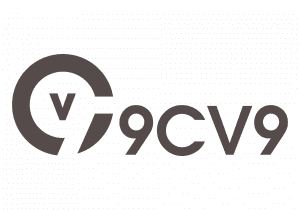









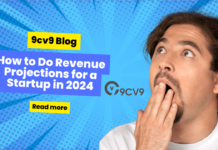
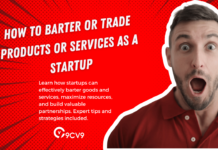



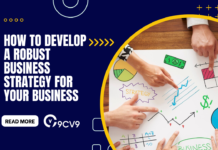
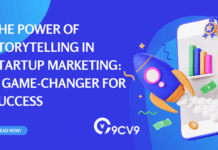

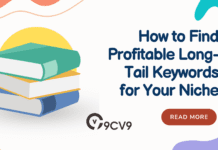



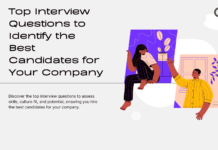


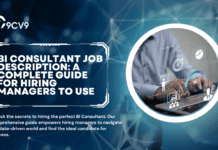





![Writing A Good CV [6 Tips To Improve Your CV] 6 Tips To Improve Your CV](https://blog.9cv9.com/wp-content/uploads/2020/06/2020-06-02-2-100x70.png)


